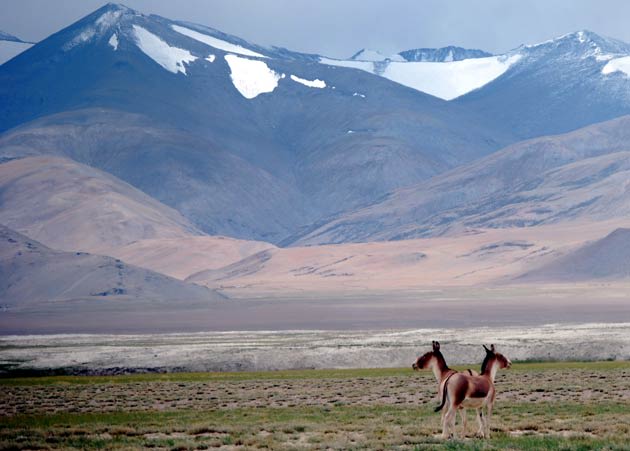A friend of mine confessed that he had not seen a single monastery on his recent visit to Ladakh as he was busy chasing birds and beasts . I looked at him rather incredulously and pronounced that it was a sacrilege to have missed out on the gompas and chortens.
Months later when I was driving through Ladakh, I realized that my eyes were drawn , not just towards the spectacular landscape but the wildlife lurking behind them . I knew I had one in a billion chance of seeing a snow leopard , but hope, they say is a dangerous thing and hence I kept wishing I would encounter one. I also looked for the golden eagle , but was content spotting the Bactrian magpie , the most characteristic bird of Ladakh .
Ladakh is indeed a birder’s paradise and I spent a few evenings looking at redstarts, finches and robins. We headed to the lakes where some of the migratory birds were protected. At Pangong Tso and Tso Moriri, we sighted a few gulls and ducks , but we could not find the bar headed goose. However nothing came close to the exclusive sighting of the rare black necked cranes. .
The mountains had spread themselves into a green carpet as we neared the lake . I looked out sleepy eyed from the window seat of my jeep, gulping another glass of green tea as the altitude inched towards 15000 feet. And then something moved in the grass.
The birder in me was all excited as I gestured to Dorjee , my guide and driver to stop the jeep. “ Cha Tungtung karbo, madam..never seen them near Pangong before, “ he said as I moved closer to take a picture of the black necked cranes .
The national bird of Kashmir is a large whitish grey bird and has a black head, red crown patch , black upper neck and legs and a white patch near the eye.
Another car stopped by and we spent some silent moments clicking away. Then Dorjee broke the silence. “Cha means bird and tung tung karbo is long legged and white,” he explained. The birds gracefully disappeared into the green valley
The black necked crane is one of the rarest in the world and a pair was sighted way back in 1976 by famous ornithologist Salim Ali. Four years later six pairs were spotted and slowly the numbers grew. I learnt from Gopi Sundar from the International Crane Foundation that these Tibetan cranes visit Ladakh probably from the river valleys of Tibet for breeding between June and September. “When the snow melts, you will find these birds coming in pairs, marking their territories and dancing- a part of their hormonal activity. You would probably find 30 nests here, “ he said adding the remaining are non breeders. The chicks later fly with their parents who are fiercely protective, guarding them from feral dogs. “Real estate is a serious issue here, “ said Gopi referring to the loss of habitat for these cranes as wetlands today are reducing to a large extent. “It’s a tough life to be a crane now , “ he laughed.
But these high altitude birds do have a spiritual significance in Buddhism as well. In fact I read later they have their own monastery and festival in Bhutan where they return every year.
The black necked cranes were not the only sightings around Pangong Tso . While driving around, I spotted something on the valley that seemed like a little boulder, except that it moved a bit. In a moment, it had disappeared. Dorjee stopped the jeep a little further and we realized we had company. Tourists flocked around the Himalayan marmots, who were standing on their hind limbs to greet them . The furry creatures were almost sleepy as they had just emerged from their long hibernation. Some of the shy marmots peeped out of the burrows only to scurry inside them, while the bolder guys allowed themselves to be stroked .
I was not so lucky to spot the ibex , the Bharal or the blue sheep or the rare Tibetan urial sheep . However we did see a big herd of kiangs or the wildasses near Tso Kar, kicking up some dust and grazing around. Some of them were curious and stared right at us, but when we drove a bit closer, they galloped away. The fleet footed kiangs , I learnt were good swimmers too .
We drove for a while and then I saw another herd of kiangs standing in a circle near the base of the mountain. Dorjee mentioned that they were mourning the death of one of their kind. We left them to their grief in their private moment and took to the jeep again , hoping for the sight of the elusive snow leopard.
Lakshmi Sharath is a media professional, a traveler, travel writer and blogger. After 15 years of sitting in front of a desk in several media organizations, she decided to travel and see the world. Since then she has covered 20 countries across five continents; her passion lies in exploring the nooks of India.

No comments:
Post a Comment